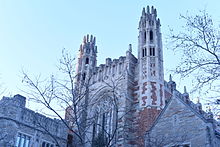History
Hartford Public High School (1638) is the third-oldest secondary school in the nation after the Collegiate School (1628) in Manhattan and the Boston Latin School (1635).

Jackson Turner Main finds that teaching in colonial days was a poorly paid, part-time, temporary job. Young men typically moved on to more secure occupations as soon as possible. There was one great exception: Reverend Thomas Clap (1703-1767), president of Yale college, 1740-1766. At his death he left an estate worth £6,656, including 600 acres of land. His wealth came from marriage and his attention to lucrative investments. [6]
Puritanism required a well educated ministry, and Harvard (founded 1636) and Yale (founded 1701) provided the men, Of the 2,466 graduates of the two schools from 1691 to 1760, 987 (40%) became ministers. However the salaries were low and increasingly ministers were unable to send their own sons to college.[7]
19th century
Henry Barnard (1811-1900) was a leading proponent of educational reform. In 1838 he led the state legislature with the passage of his bill. It provided for "the better supervision of the common schools", and established a board of "commissioners of common schools" in the state. He was the secretary of the board from 1838 until its abolition in 1842. He worked indefatigably to reorganize and reform the common school system of the state, thus earning a national reputation as an educational reformer.[8] [9] After taking a leading role in education in Rhode Island in the 1840s he returned to Connecticut. From 1851 to 1855, he was "superintendent of common schools", and principal of the Connecticut State Normal School at New Britain.[10]
In 1832, Quaker schoolteacher Prudence Crandall created the first integrated schoolhouse in the United States by admitting Sarah Harris, the daughter of a free African-American farmer in the local community, to her Canterbury Female Boarding School in Canterbury. Many prominent townspeople objected and pressured to have Harris dismissed from the school, but Crandall refused. Families of the current students removed their daughters. Consequently, Crandall ceased teaching white girls altogether and opened up her school strictly to African American girls.[11] In 1995, the Connecticut General Assembly designated Prudence Crandall as the state's official heroine.[12]
2012: Sandy Hook Elementary School shooting
|
Main article: Sandy Hook Elementary School shooting |
On December 14, 2012, Adam Lanza shot and killed 26 people, including 20 children and 6 staff, at Sandy Hook Elementary School in the Sandy Hook village of Newtown, Connecticut, and then killed himself.[13]
